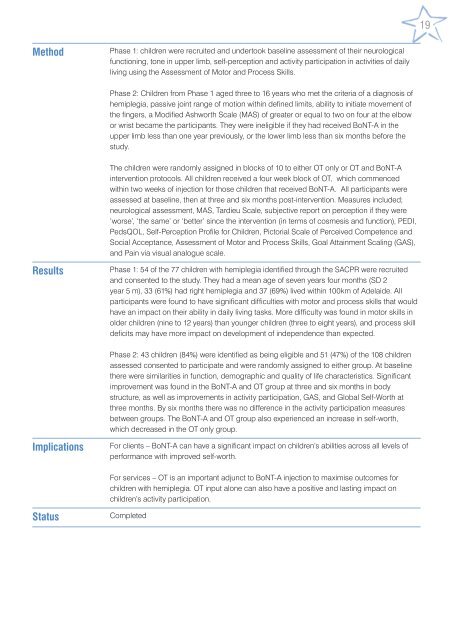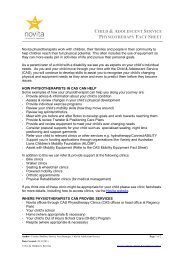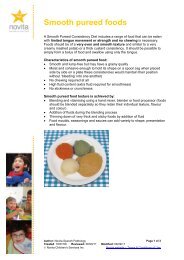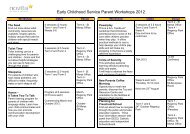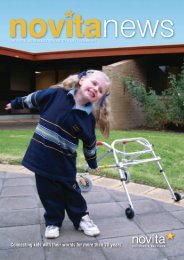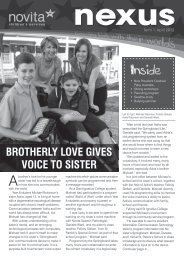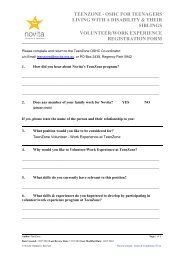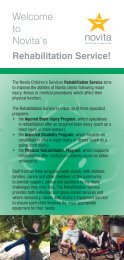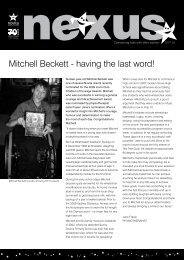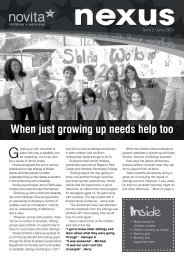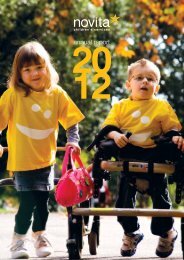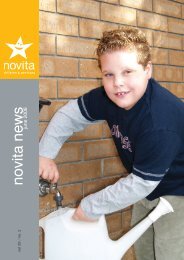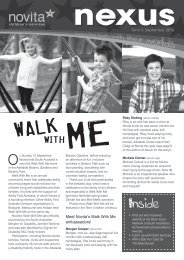Novita Research Report - 2004 to 2007 - Novita Children's Services
Novita Research Report - 2004 to 2007 - Novita Children's Services
Novita Research Report - 2004 to 2007 - Novita Children's Services
- No tags were found...
Create successful ePaper yourself
Turn your PDF publications into a flip-book with our unique Google optimized e-Paper software.
19MethodPhase 1: children were recruited and under<strong>to</strong>ok baseline assessment of their neurologicalfunctioning, <strong>to</strong>ne in upper limb, self-perception and activity participation in activities of dailyliving using the Assessment of Mo<strong>to</strong>r and Process Skills.Phase 2: Children from Phase 1 aged three <strong>to</strong> 16 years who met the criteria of a diagnosis ofhemiplegia, passive joint range of motion within defined limits, ability <strong>to</strong> initiate movement ofthe fingers, a Modified Ashworth Scale (MAS) of greater or equal <strong>to</strong> two on four at the elbowor wrist became the participants. They were ineligible if they had received BoNT-A in theupper limb less than one year previously, or the lower limb less than six months before thestudy.The children were randomly assigned in blocks of 10 <strong>to</strong> either OT only or OT and BoNT-Aintervention pro<strong>to</strong>cols. All children received a four week block of OT, which commencedwithin two weeks of injection for those children that received BoNT-A. All participants wereassessed at baseline, then at three and six months post-intervention. Measures included;neurological assessment, MAS, Tardieu Scale, subjective report on perception if they were‘worse’, ‘the same’ or ‘better’ since the intervention (in terms of cosmesis and function), PEDI,PedsQOL, Self-Perception Profile for Children, Pic<strong>to</strong>rial Scale of Perceived Competence andSocial Acceptance, Assessment of Mo<strong>to</strong>r and Process Skills, Goal Attainment Scaling (GAS),and Pain via visual analogue scale.ResultsPhase 1: 54 of the 77 children with hemiplegia identified through the SACPR were recruitedand consented <strong>to</strong> the study. They had a mean age of seven years four months (SD 2year 5 m), 33 (61%) had right hemiplegia and 37 (69%) lived within 100km of Adelaide. Allparticipants were found <strong>to</strong> have significant difficulties with mo<strong>to</strong>r and process skills that wouldhave an impact on their ability in daily living tasks. More difficulty was found in mo<strong>to</strong>r skills inolder children (nine <strong>to</strong> 12 years) than younger children (three <strong>to</strong> eight years), and process skilldeficits may have more impact on development of independence than expected.Phase 2: 43 children (84%) were identified as being eligible and 51 (47%) of the 108 childrenassessed consented <strong>to</strong> participate and were randomly assigned <strong>to</strong> either group. At baselinethere were similarities in function, demographic and quality of life characteristics. Significantimprovement was found in the BoNT-A and OT group at three and six months in bodystructure, as well as improvements in activity participation, GAS, and Global Self-Worth atthree months. By six months there was no difference in the activity participation measuresbetween groups. The BoNT-A and OT group also experienced an increase in self-worth,which decreased in the OT only group.ImplicationsFor clients – BoNT-A can have a significant impact on children’s abilities across all levels ofperformance with improved self-worth.For services – OT is an important adjunct <strong>to</strong> BoNT-A injection <strong>to</strong> maximise outcomes forchildren with hemiplegia. OT input alone can also have a positive and lasting impact onchildren’s activity participation.StatusCompleted


